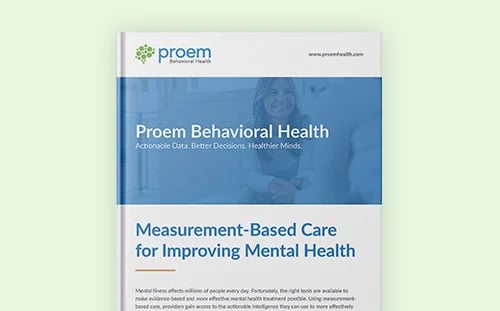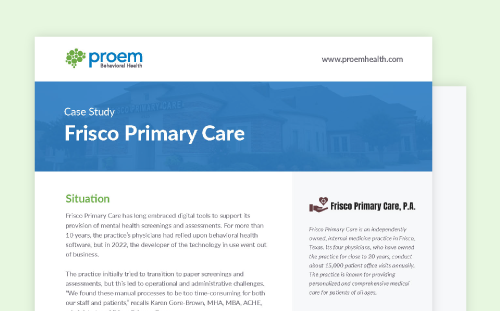
Q&A with CHE Behavioral Health Services Chief Clinical Officer Dr. Jennifer Birdsall
In January, nView Health announced that it had executed a multi-year license agreement with CHE Behavioral Health Services to use nView's measurement-based care (MBC) solutions. CHE is a multispecialty clinical group dedicated to increasing access to mental health services and reducing the stigma of mental health conditions.
In this interview, CHE Chief Clinical Officer Dr. Jennifer Birdsall discusses why CHE has prioritized measurement-based care, identifies the reasons why CHE chose to partner with nView, explains how CHE is deploying nView's MBC solutions, and shares what she thinks is the future of MBC in behavioral health.
.png?width=50&name=nView%20Icons%20(7).png) What motivated CHE to pursue behavioral health outcome measures solutions?
What motivated CHE to pursue behavioral health outcome measures solutions?
![]() Dr. Jennifer Birdsall: For CHE, there are two main reasons. First and foremost is the clinical side. The second is the business aspect of what measurement-based care can do for our organization.
Dr. Jennifer Birdsall: For CHE, there are two main reasons. First and foremost is the clinical side. The second is the business aspect of what measurement-based care can do for our organization.
From the clinical side, CHE Behavioral Health Services is, at its core, committed to gold standard and evidence-based care. We know from the research on outcome measures and MBC that patients randomly assigned to MBC have significantly better outcomes than patients randomly assigned to "care as usual." In our effort and mission to provide evidence-based care, we recognized we should be leveraging MBC to improve our client outcomes.
Why are outcomes better when you implement MBC? We know that when you are routinely measuring symptoms and other important outcome variables, such as functioning, therapeutic alliance, and satisfaction measures, you can capture the client's fluctuations in real-time. This allows the treatment plan to be adjusted in real-time so you can achieve better clinical outcomes and help clients meet their treatment goals faster.
From the business perspective, we're moving to a world where incorporating MBC is not going to be a choice. The world of value-based care keeps coming up and is eventually going to become the standard even in behavioral health. We want to make sure we are setting ourselves up to have that process in place and be ready to deliver that data to whoever is asking for it. We may need to deliver data in terms of value and outcomes to our insurance carriers. Within our organizations, we accept insurance, so we need to be able to provide that to the carriers we contract with.
In addition, behavioral health is becoming a very competitive marketplace. As you strive to be a provider of choice and market your services directly to future clients or to potential referring organizations, many will ask about the benefits of your services. What's your data, i.e., clinical outcomes? How do we know clients will improve under your care? Why should we choose CHE over another behavioral health provider? In other words, how can we be confident in the quality and value of the services you are providing? These kinds of questions are why we are highly motivated to start incorporating MBC from the business perspective.
.png?width=50&name=nView%20Icons%20(7).png) How else will incorporating measurement-based care help CHE and its clients?
How else will incorporating measurement-based care help CHE and its clients?
![]() JB: At CHE, we value best practices and achieving the best client outcomes. When we think about measurement-based care, it's not just for the patients. There are benefits we anticipate and expect to achieve for everyone involved — the patient, the treating provider, and our organization.
JB: At CHE, we value best practices and achieving the best client outcomes. When we think about measurement-based care, it's not just for the patients. There are benefits we anticipate and expect to achieve for everyone involved — the patient, the treating provider, and our organization.
For patients, when we push out measures automatically and request our clients fill them out at the interval we decide, it can help the client better understand the nature of their condition. They're actively monitoring it and paying attention to their own symptom fluctuations. To that end, they're going to become more attuned to changes in their symptoms and potential signs of relapse. Ultimately, this will help them be a much more active participant in their care.
When you think about best practices and MBC, it really is collaborative. Collaboration is better achieved when the client and therapist discuss the measure results and use that information to inform the care plan together. For example, consider a provider who notices a client indicated that they are having a lot of trouble with sleep on the last depression symptom measure they completed. Even if the client didn't report this to the provider in session, now the provider knows to ask about it. They can say things like, "Do we need to check in on your sleep? We want to make sure you are sleeping well, so let's take some time today to make sure we can address your recent sleep difficulties." Those kinds of conversations are going to increase client engagement and motivation and strengthen the relationship with their provider.
Building on what I said earlier about the provider side, when we add tools to help providers identify whether a client is improving or symptoms are worsening, that will allow them to do their job better. They can adjust their treatment plan and the therapeutic interventions in real time where they otherwise might not have, or at least not as quickly.
From the organizational perspective, we can use data at the population level to strengthen our quality improvement efforts. For example, we can look at data across national regions or across providers. Do we have a provider who may need more training or clinical consultation? Do we have a provider who stands out as exceptional on their alliance scores or achieving symptom reduction faster on average? This could be someone who we want to use as a trainer to help emulate their successful approaches across our organization. Maybe we find that when we look across diagnoses, we are doing amazing for our clients who have a depression diagnosis, but we are not seeing the outcomes we anticipated for clients with a different diagnosis. Now that we identified these differences, what can we do? What are the program improvements and training opportunities we can put in place to ensure we are hitting the outcomes we want for that diagnosis as well?
For CHE, MBC is going to help us improve outcomes across every aspect, from the patient to the provider to our organization. It's amazing when you think about it that way.
.png?width=50&name=nView%20Icons%20(7).png) Why did CHE choose nView's MBC solutions?
Why did CHE choose nView's MBC solutions?
![]() JB: At CHE, we are extremely excited to work with nView for several reasons. We feel that nView effectively combines clinical and technology expertise in this space. We have just started navigating and developing our own measurement-based care solutions with them. They have an exceptional client experience team. It's been amazing to work with them as we develop our workflows and see firsthand how customizable nView has made its solutions.
JB: At CHE, we are extremely excited to work with nView for several reasons. We feel that nView effectively combines clinical and technology expertise in this space. We have just started navigating and developing our own measurement-based care solutions with them. They have an exceptional client experience team. It's been amazing to work with them as we develop our workflows and see firsthand how customizable nView has made its solutions.
From the technology side, nView provides the platform and support to streamline routine measurement: pushing the measures to the client, collecting the data, charting it, sharing it with the provider, and sharing it with the organization. Such streamlining is key. This work needs to be automated or we run the risk of measurements not being done timely and consistently. The way that nView's platform automates this process is amazing.
On the clinical side, nView's focus on behavioral health means it has already curated many outcome measures that we get to choose from and implement. It's great that we do not need to reinvent the wheel or create these from the bottom up. We get to use a pre-developed set of measurement tools specific to behavioral health diagnoses.
At the same time, nView can customize and add measures to its technology. CHE has some unique measures we require for reporting with outside agencies. We have been able to give those measures to the nView team to add into their system. It's been easy to develop our outcome measures with best practices and have access to valid, reliable, and customizable clinical measures.
From the customer experience side, it's been wonderful to have a dedicated, external organization ensuring we are following best practices, meeting our deadlines, and making sure the workflows and automated technology aspects are happening. If we decide we need to add new measures or change frequencies, we have a dedicated customer support group at nView that can work on that for us, so it doesn't get missed or pushed to the back burner due to competing priorities. We want to make sure we are always staying up to date on our MBC efforts. This is possible by having that dedicated partner in nView.
.png?width=34&name=nView%20Icons%20(7).png) How is CHE deploying nView's solutions?
How is CHE deploying nView's solutions?
![]() JB: We are taking advantage of all the service components nView has to offer. We are using the clinical measures they have already curated and have in their repertoire, which is allowing us to move ahead and get started with measurement-based care. That certainly makes starting and delivering measures much easier. A big part of this is figuring out which measures to select, so having that taken care of has been wonderful. We are also using the nView platform to help us with collecting data and charting it, communication and analysis.
JB: We are taking advantage of all the service components nView has to offer. We are using the clinical measures they have already curated and have in their repertoire, which is allowing us to move ahead and get started with measurement-based care. That certainly makes starting and delivering measures much easier. A big part of this is figuring out which measures to select, so having that taken care of has been wonderful. We are also using the nView platform to help us with collecting data and charting it, communication and analysis.
.png?width=34&name=nView%20Icons%20(7).png) What initiatives does CHE expect nView's measurement-based care solutions to support?
What initiatives does CHE expect nView's measurement-based care solutions to support?
![]() JB: nView's dedicated team of clinical and technological experts on measurement-based care are going to help CHE implement and improve our measurement-based workflows quickly and efficiently. nView is then going to help us stay current with our measures and measure collection process as changes occur in the behavioral health industry or in our own practice. What I have found is that expected or required measures, pending your industry, can change even on a yearly basis, and we always want to stay at the forefront of the gold standards and best practices and meet the various needs of the different constituents we work with. Collaborating with nView will help us do all this in real-time.
JB: nView's dedicated team of clinical and technological experts on measurement-based care are going to help CHE implement and improve our measurement-based workflows quickly and efficiently. nView is then going to help us stay current with our measures and measure collection process as changes occur in the behavioral health industry or in our own practice. What I have found is that expected or required measures, pending your industry, can change even on a yearly basis, and we always want to stay at the forefront of the gold standards and best practices and meet the various needs of the different constituents we work with. Collaborating with nView will help us do all this in real-time.
The goal of bringing in nView is to help us do MBC with best practices. That means routine, automated measuring and making sure the data is not just collected but reviewed and then used to inform care planning and improve our organizational quality improvement efforts. Ultimately, it boils down to ensuring clients are getting the best care and we achieve the best business outcomes. That's helping us manage our payer contracts, whether it's securing new contracts or negotiating better reimbursement rates, and then also the direct-to-consumer and direct-to-business partner referral growth. Being able to use that outcome data to demonstrate the value of the services we provide at CHE will help in those areas and more.
.png?width=34&name=nView%20Icons%20(7).png) What roles do you expect outcome measures and measurement-based care will play in the future of behavioral healthcare?
What roles do you expect outcome measures and measurement-based care will play in the future of behavioral healthcare?
![]() JB: When I think about the future, what you consistently see now when you're reading about behavioral healthcare is the movement toward value-based care and measurement-based care. That is where the industry is headed. While it has been more complex to determine how to apply MBC and value-based care to behavioral health, it's absolutely coming down the pipeline. Therefore, all of us in this industry are going to need to start collecting and producing outcome measures to show the value of what we're doing and the outcomes our clients are achieving. This is the right time to get ahead of that curve and start implementing those workflows.
JB: When I think about the future, what you consistently see now when you're reading about behavioral healthcare is the movement toward value-based care and measurement-based care. That is where the industry is headed. While it has been more complex to determine how to apply MBC and value-based care to behavioral health, it's absolutely coming down the pipeline. Therefore, all of us in this industry are going to need to start collecting and producing outcome measures to show the value of what we're doing and the outcomes our clients are achieving. This is the right time to get ahead of that curve and start implementing those workflows.





.png)
.png)





